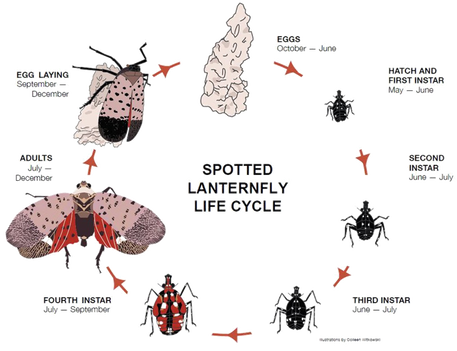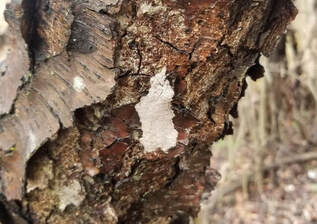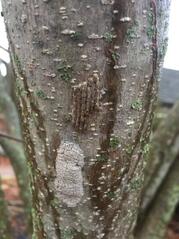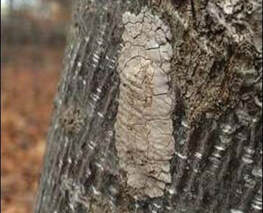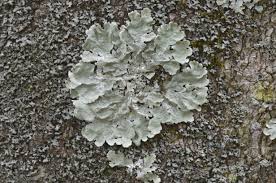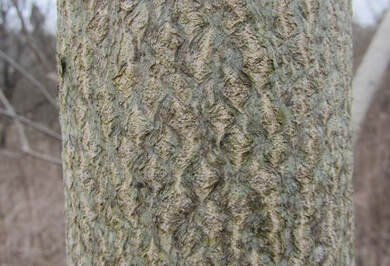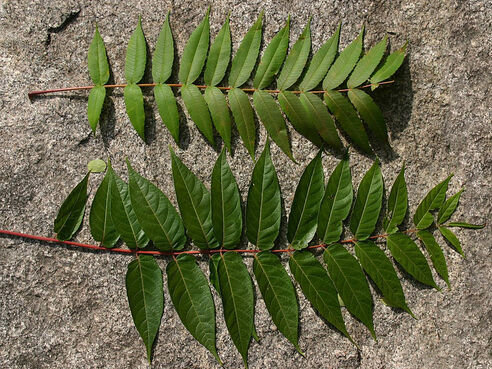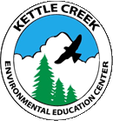Spotted Lanternfly
Spotted Lanternfly
The Spotted Lanternfly (SLF, or Lanternfly) is an invasive planthopper that was first discovered in PA in 2014. It is a threat to many plants that are important to our state and local economy such as grapes and hardwoods. Monroe County is included in the PA Spotted Lanternfly quarantine. As a citizen there are several things you can do to help us stop the spread of the insect.
Spotted Lanternfly Lifecycle & Control
The Lanternfly has only one life cycle per year. They hatch from eggs starting in April and continue to grow until they have reached adulthood sometime around August. The Spotted Lanternfly has four nymph stages. The first three instar stages are crawling insects with black with white spots and the fourth instars are crawling insects that are red with white dots and black stripes. When Spotted Lanternflies reach adulthood they are around 1 inch and can fly. These new adults lay their eggs starting in September and continue laying until they die in December.
The Spotted Lanternfly (SLF, or Lanternfly) is an invasive planthopper that was first discovered in PA in 2014. It is a threat to many plants that are important to our state and local economy such as grapes and hardwoods. Monroe County is included in the PA Spotted Lanternfly quarantine. As a citizen there are several things you can do to help us stop the spread of the insect.
Spotted Lanternfly Lifecycle & Control
The Lanternfly has only one life cycle per year. They hatch from eggs starting in April and continue to grow until they have reached adulthood sometime around August. The Spotted Lanternfly has four nymph stages. The first three instar stages are crawling insects with black with white spots and the fourth instars are crawling insects that are red with white dots and black stripes. When Spotted Lanternflies reach adulthood they are around 1 inch and can fly. These new adults lay their eggs starting in September and continue laying until they die in December.
Spotted Lanternflies have a very large host range and will feed off of over 65 different plant species. It is important to note that Spotted Lanternflies will not kill every tree that they touch and it is not necessary to treat every tree on a property. There are both mechanical and chemical controls for the Spotted Lanternfly.
Circle Trap
The preferred method of trapping nymph and adult Spotted Lanternflies is the circle trap. The circle trap is a funnel-shaped trap that collects the spotted lanternflies and traps them as they crawl upwards in a tree. Circle traps are preferred over the use of sticky bands as they have no by-catch. Circle traps can be purchased or made with household materials. The video below will describe to you how to create a circle trap. A list of materials needed to create your own circle trap can be found here.
Circle Trap
The preferred method of trapping nymph and adult Spotted Lanternflies is the circle trap. The circle trap is a funnel-shaped trap that collects the spotted lanternflies and traps them as they crawl upwards in a tree. Circle traps are preferred over the use of sticky bands as they have no by-catch. Circle traps can be purchased or made with household materials. The video below will describe to you how to create a circle trap. A list of materials needed to create your own circle trap can be found here.
Sticky Bands
Sticky bands are tape like bands that are wrapped around a tree and catch the Spotted Lanternfly as they climb up the tree. Sticky bands unfortunately also can capture beneficial insects, small mammals, and song birds. If you chose to use a sticky trap on your property, make sure that you also install a wildlife barrier made of window screening to minimize bycatch other organisms. Screening material can be placed above around the sticky band. It should be secured at the top of the sticky band, and loose around the bottom.
Chemical Control
Although spotted lanternflies appear to be affected by insecticides, residents should choose the least toxic management methods before resorting to chemical use. A few spotted lanternflies feeding on well developed, healthy landscape trees are considered unlikely to cause permanent damage. Consider using trapping or squishing methods before turning to toxic chemicals.
Typical home remedies, like dawn dish soap, can cause ecological damage and/or be harmful to human and pet health.
It is hard to deliver the insecticide to the pest during much of its lifecycle. Insecticides are most effective when used around mid-July, when the late instars and adults are attempting to find their host trees. Applying insecticides to the eggs will not be as highly effective as it would be during other times of the year.
Whenever using chemical control methods consider the following:
- Consider non-chemical control mechanisms for whatever pest you are dealing with before resorting to chemical controls.
- It is important to make sure that you are using chemicals that are registered by the Environmental Protection Agency (EPA).
- Use the correct amount of pesticide that is indicated on the product label
- Read the product label and follow the directions carefully
- Be careful to avoid areas important to our pollinators (flowering plants) and water resources (near streams, wetlands, etc.)
- Make sure that you are keeping yourself safe by wearing clean protective clothing and washing your hands.
- Consider hiring a professional applicator who is trained and has specialized equipment when taking the chemical control route.
Spotted Lanternfly Egg Masses
Spotted lanternflies lay their eggs in the fall. Egg masses contain between 30-50 eggs and can be laid on many different objects including tree trunks, lawn furniture, cement blocks, telephone poles, and other hard surfaces. Freshly laid egg masses are white and look like unevenly spread mortar or putty. As they age, they will turn light tan or gray and start cracking. After the eggs hatch, you will find emergence holes on the masses where the nymphs crawled out.
Be careful not to confuse lichens with spotted lanternfly egg masses. Lichens are mossy-looking light green or white colored simple organisms that grow on tree bark.
What to do if you find egg masses?
If you find egg masses, scrape them off using an old gift card or a putty knife. It is best to scrape the mass into a closed container filled with rubbing alcohol or hand sanitizer. If you see a mass when you are not carrying a scraping implement with you, do your best to smash the eggs. You will be able to hear them pop and juice will ooze out if you did a good job. If you do not apply enough pressure, the eggs will still be viable. View this video for more detailed instruction: https://extension.psu.edu/how-to-remove-spotted-lanternfly-eggs.
Eggs are just as likely to pose risk of hitchhiking as adults, so be careful to inspect anything moving from an area that has been infested before taking it to the new location.
If you see an adult or eggs, please call the Monroe County Conservation District to report a sighting! Remember to take a picture and then please; SQUASH, STAMP, or SCRAPE the insect/eggs away! If you are traveling anywhere outside of the county or within the quarantine zone remember to check your vehicle and always Look Before You Leave.
Are there any chemicals that I can use on the egg masses?
Although spotted lanternflies appear to be affected by insecticides, residents should choose the least toxic management methods before resorting to chemical use. A few spotted lanternflies feeding on well developed, healthy landscape trees are considered unlikely to cause permanent damage. Consider using trapping or squishing methods before turning to toxic chemicals.
Typical home remedies, like dawn dish soap, can cause ecological damage and/or be harmful to human and pet health.
It is hard to deliver the insecticide to the pest during much of its lifecycle. Insecticides are most effective when used around mid-July, when the late instars and adults are attempting to find their host trees. Applying insecticides to the eggs will not be as highly effective as it would be during other times of the year.
Whenever using chemical control methods consider the following:
If you find egg masses, scrape them off using an old gift card or a putty knife. It is best to scrape the mass into a closed container filled with rubbing alcohol or hand sanitizer. If you see a mass when you are not carrying a scraping implement with you, do your best to smash the eggs. You will be able to hear them pop and juice will ooze out if you did a good job. If you do not apply enough pressure, the eggs will still be viable. View this video for more detailed instruction: https://extension.psu.edu/how-to-remove-spotted-lanternfly-eggs.
Eggs are just as likely to pose risk of hitchhiking as adults, so be careful to inspect anything moving from an area that has been infested before taking it to the new location.
If you see an adult or eggs, please call the Monroe County Conservation District to report a sighting! Remember to take a picture and then please; SQUASH, STAMP, or SCRAPE the insect/eggs away! If you are traveling anywhere outside of the county or within the quarantine zone remember to check your vehicle and always Look Before You Leave.
Are there any chemicals that I can use on the egg masses?
Although spotted lanternflies appear to be affected by insecticides, residents should choose the least toxic management methods before resorting to chemical use. A few spotted lanternflies feeding on well developed, healthy landscape trees are considered unlikely to cause permanent damage. Consider using trapping or squishing methods before turning to toxic chemicals.
Typical home remedies, like dawn dish soap, can cause ecological damage and/or be harmful to human and pet health.
It is hard to deliver the insecticide to the pest during much of its lifecycle. Insecticides are most effective when used around mid-July, when the late instars and adults are attempting to find their host trees. Applying insecticides to the eggs will not be as highly effective as it would be during other times of the year.
Whenever using chemical control methods consider the following:
- Consider non-chemical control mechanisms for whatever pest you are dealing with before resorting to chemical controls.
- It is important to make sure that you are using chemicals that are registered by the Environmental Protection Agency (EPA).
- Use the correct amount of pesticide that is indicated on the product label
- Read the product label and follow the directions carefully
- Be careful to avoid areas important to our pollinators (flowering plants) and water resources (near streams, wetlands, etc.)
- Make sure that you are keeping yourself safe by wearing clean protective clothing and washing your hands.
- Consider hiring a professional applicator who is trained and has specialized equipment when taking the chemical control route.
Tree of Heaven Removal
Tree of heaven (Ailanthus altissima) is the Spotted Lanternfly’s preferred host tree. A host tree is a target tree that provides the insect with nourishment and support during all, or some, of its life stages. Tree of heaven is also an invasive that came to our continent from Asia. The tree of heaven has rapid growth and can reach a height of 80 ft. with a 6 ft. diameter. The bark resembles cantaloupe skin. The tree has a distinct smell, that some compare to peanut butter that can be noticed when snapping off a twig or branch. The tree typically grows in dense colonies and reproduces through both seed and through root suckers. Root suckers can emerge up to 50 ft. away from the parent tree.
Getting rid of Tree of Heaven is not as easy as just cutting it down due to its ability to produce root suckers. Hand pulling root suckers when possible works to help prevent the spread of the tree. The best way to completely rid an area of Tree of Heaven is to target the roots with a systemic herbicide in mid to late summer.
Check your property for any existing populations. Look at the references listed at the bottom of this page for a tree ID guide and more information.
Tree of heaven (Ailanthus altissima) is the Spotted Lanternfly’s preferred host tree. A host tree is a target tree that provides the insect with nourishment and support during all, or some, of its life stages. Tree of heaven is also an invasive that came to our continent from Asia. The tree of heaven has rapid growth and can reach a height of 80 ft. with a 6 ft. diameter. The bark resembles cantaloupe skin. The tree has a distinct smell, that some compare to peanut butter that can be noticed when snapping off a twig or branch. The tree typically grows in dense colonies and reproduces through both seed and through root suckers. Root suckers can emerge up to 50 ft. away from the parent tree.
Getting rid of Tree of Heaven is not as easy as just cutting it down due to its ability to produce root suckers. Hand pulling root suckers when possible works to help prevent the spread of the tree. The best way to completely rid an area of Tree of Heaven is to target the roots with a systemic herbicide in mid to late summer.
Check your property for any existing populations. Look at the references listed at the bottom of this page for a tree ID guide and more information.
Quarantine Information- Look Before You Leave!
Monroe County is in a Quarantine Zone, What does that mean?
The Spotted Lanternfly came to Pennsylvania, specifically Berks County, in 2014. Since then, the
Lanternfly has spread to 14 counties in PA spanning from Lancaster to Monroe. These counties are in a “Quarantine Zone” requiring businesses to monitor anything being exported from or within these counties. As the insect moves into new counties, the area of quarantine will expand and change. The most recent map can be found online here.
Here is how the quarantine may affect you…
Business Owners and Managers
These insects do not present any issue to humans, as the don’t bite or sting, but they can be very damaging to the agriculture industry. Thank you for doing your part to help stop the spread of this invasive insect. If you have any questions or concerns, please call our office. Look out for future workshops that will be held by our district on spotted lanternfly control.
Resources:
Action Kit for Businesses
Tree of Heaven Information
Tree of Heaven ID Video
Video Demonstration of Egg Mass Removal
Spotted Lanternfly Management for Homeowners w/ list of example Control Products
Monroe County is in a Quarantine Zone, What does that mean?
The Spotted Lanternfly came to Pennsylvania, specifically Berks County, in 2014. Since then, the
Lanternfly has spread to 14 counties in PA spanning from Lancaster to Monroe. These counties are in a “Quarantine Zone” requiring businesses to monitor anything being exported from or within these counties. As the insect moves into new counties, the area of quarantine will expand and change. The most recent map can be found online here.
Here is how the quarantine may affect you…
Business Owners and Managers
- All businesses should get a permit issued through PDA. A permit shows that you have been through proper training and know how to follow the rules of the quarantine. To obtain a permit, sign up for the free online course at extension.psu.edu/spotted-lanternfly-permit-training
- Business owners and managers should keep record of training, shipping, vehicle inspections, and other SLF control measures for a minimum for 2 years. The person preforming these measures must be identified. There is no required template, but this documentation is a requirement.
- Any business that engages with mulch production or logging must enter compliance with PDA and inspect any truck or trailer being used. Contact our area’s Bureau of Plant Industry supervisor, Richard J. Malak at [email protected]
- Any entity that sells plants should have them inspected by PDA to receive a phytosanitary certificate. If you have a Nursery/Greenhouse License or a Nursery’s Dealer License you should already be covered. A plant inspector will check your plants.
- If you are a resident living in a quarantine area, make sure to inspect your vehicles and any other item that you are moving to another area in the state and beyond. You can print and complete the PDA’s approved checklist. This is a legal document that shows you have inspected properly and are in compliance. https://www.agriculture.pa.gov/Plants_Land_Water/PlantIndustry/Entomology/spotted_lanternfly/quarantine/Documents/SLF_Checklist_for_Residents.pdf
- Avoid parking vehicles or storing materials under or around trees and tree lines.
- Report any sightings of Spotted Lanternflies on PDA’s Spotted Lanternfly Reporting Tool and call the District to report your sighting
These insects do not present any issue to humans, as the don’t bite or sting, but they can be very damaging to the agriculture industry. Thank you for doing your part to help stop the spread of this invasive insect. If you have any questions or concerns, please call our office. Look out for future workshops that will be held by our district on spotted lanternfly control.
Resources:
Action Kit for Businesses
Tree of Heaven Information
Tree of Heaven ID Video
Video Demonstration of Egg Mass Removal
Spotted Lanternfly Management for Homeowners w/ list of example Control Products
|
|
8050 Running Valley Road
Stroudsburg, PA 18360
Stroudsburg, PA 18360
|
|
|
